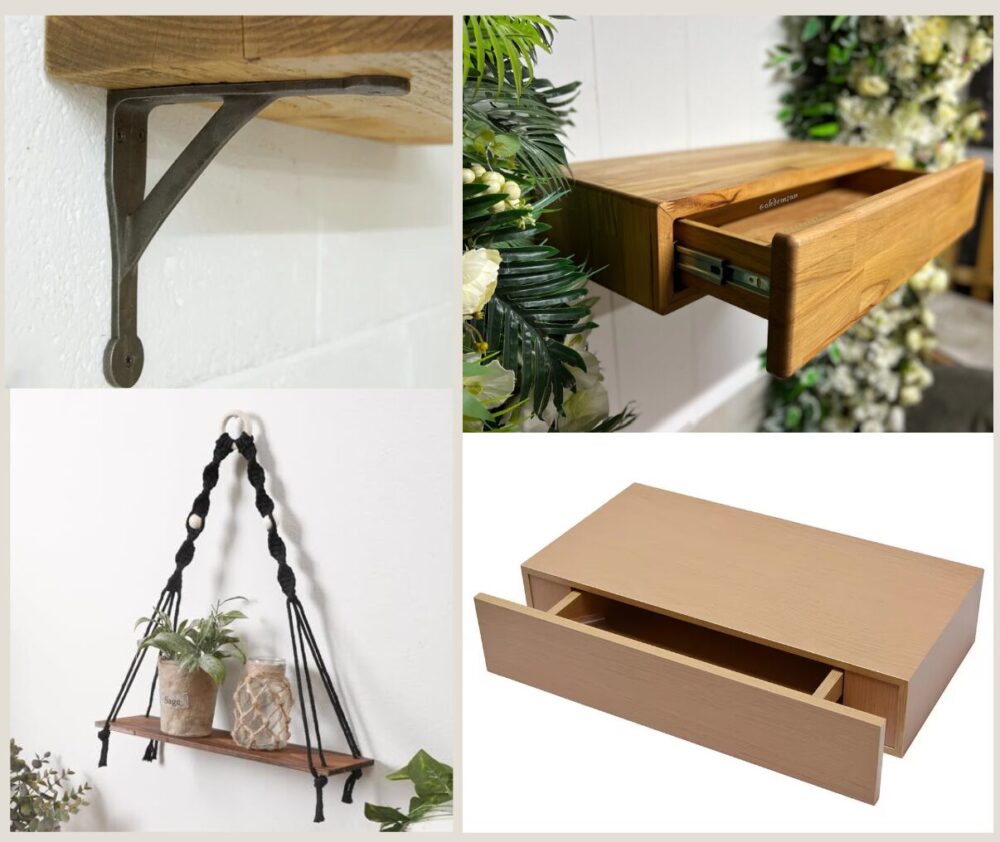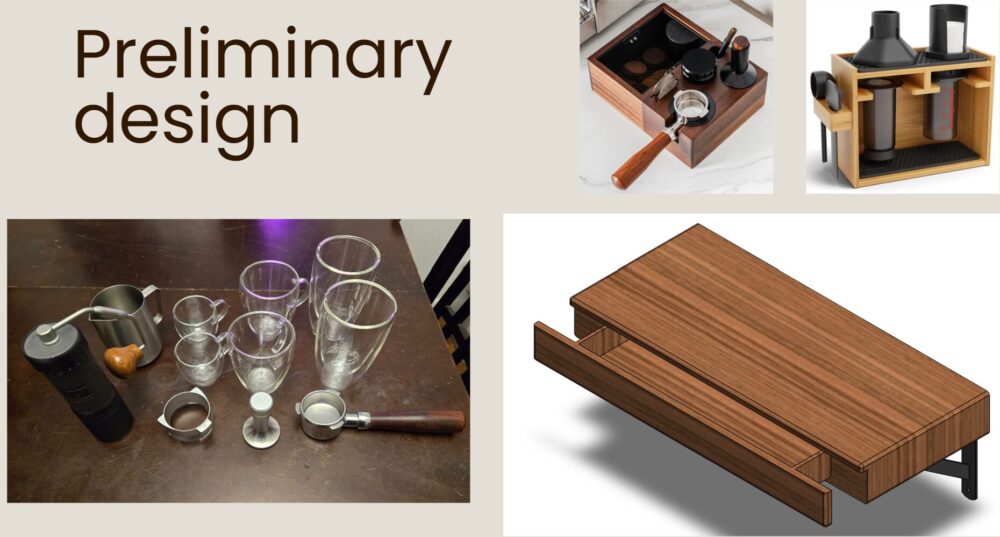As my design for a coffee accessory shelf has evolved, so too has my aesthetic direction. Initially, I leaned toward an “urban ivy” concept—an industrial-modern approach inspired by Seattle’s shipyards, skyline, and abundance of greenery. That vision centered around a concrete-like wood finish, Brutalist forms, and minimalist touches. However, as the project progressed, I found myself increasingly drawn to warmer, more organic elements. This shift led me to embrace a rustic-bohemian blend, combining the earthy rawness of natural materials with eclectic, artistic accents.
The new design emphasizes natural textures, soft contrasts, and a sense of warmth and character. Instead of a faux-concrete finish, I’m now focusing on darker stained woods or affordable alternatives to walnut, which, while beautiful, is currently out of budget. I’m exploring other hardwoods with visible grain—like pine, alder, or even plywood with a dark stain—that can offer a similar aesthetic without the cost. This adjustment has been both practical and creatively freeing, opening up new possibilities for customization and experimentation.
My inspiration for this revised direction comes from a blend of rustic interiors and bohemian decor. I was particularly influenced by cast iron shelf brackets, along with floating nightstand designs that integrate a small drawer for hidden storage. The idea of rope or wire trapeze-style supports came from Pinterest visuals and handmade shelving examples, contributing a touch of playfulness and handcrafted charm. Bohemian interior design resources encouraged the integration of greenery and woven textures, bringing life and softness to the overall design.
 Functionality remains a priority. The shelf will feature an integrated drawer to store coffee tools—like scoops, filters, or stirrers—alongside carved indentations for holding mugs securely. Greenery, whether real or artificial, will be incorporated. These elements enhance the bohemian spirit while remaining in line with the rustic base. The use of dark-stained wood, exposed hardware, and possibly salvaged materials ties everything together in a way that feels lived-in and authentic.
Functionality remains a priority. The shelf will feature an integrated drawer to store coffee tools—like scoops, filters, or stirrers—alongside carved indentations for holding mugs securely. Greenery, whether real or artificial, will be incorporated. These elements enhance the bohemian spirit while remaining in line with the rustic base. The use of dark-stained wood, exposed hardware, and possibly salvaged materials ties everything together in a way that feels lived-in and authentic.
I considered and sketched out multiple design variations before settling on this hybrid aesthetic. My original industrial concept felt too cold for the kind of intimate, homey environment I envisioned. A contemporary version with clean lines and glossy finishes was also explored, but it lacked the tactile warmth and soul I was after. The rustic-bohemian combination offered the right balance—grounded yet expressive, functional yet personal.
 So far, I’ve completed several preliminary sketches and begun translating the key dimensions and features into CAD. These digital plans are helping to refine the proportions of the drawer, bracket placements, and support elements. I’ve also started prototyping the drawer mechanism with inexpensive materials, allowing me to work out any kinks before investing in final components.
So far, I’ve completed several preliminary sketches and begun translating the key dimensions and features into CAD. These digital plans are helping to refine the proportions of the drawer, bracket placements, and support elements. I’ve also started prototyping the drawer mechanism with inexpensive materials, allowing me to work out any kinks before investing in final components.
Citations
v.pinimg.com.gslb.pinterest.com
https://landmarksarchitects.com/modern-bohemian-interior-design/
https://www.etsy.com/listing/781116621/cast-iron-shelf-bracket-antique-iron
https://www.etsy.com/listing/1172749194/floating-nightstand-with-drawer-shelf
https://www.ebay.com/itm/335268712709


2 Comments. Leave new
Yo, what up kyle
.
I loved that your project is evolving over time. The documentation for this project is going to be impressive once you are done with it. I like the idea of incorporating natural textures, such as darker stained wood and greenery, but even with this shift, it shouldn’t detract from its functionality. I have a question that others have touched on as well: when it comes to finding an affordable alternative to walnut, consider how the wood will age. Do you want it to have that particular look? Also, think about how resistant the wood will be to dents, as some types of wood are a bit softer. This might be a bit obvious, so it doesn’t really need to be noted, but are you using a coat to protect the wood and stain? Additionally, I think you should pay attention to the direction of the grain, as that can enhance the visual appeal of your product. Either way, I’m looking forward to the final result. Mb for the long comment.
Yo Kyle, I love the shift toward a rustic-bohemian vibe—it adds so much warmth and personality. One small critique: I’d love a bit more clarity on how the final materials will hold up over time. Also, have you thought about how the drawer design might evolve as you move from prototype to final build?